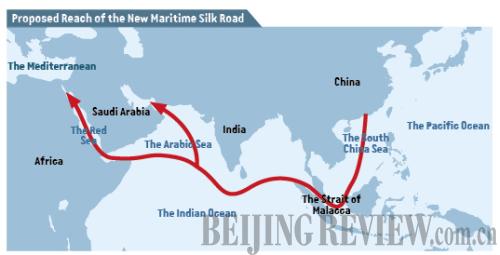

Fujian is one of the areas that have been actively engaged in developing its ports, particularly the one in Quanzhou, a city recognized by UNESCO as the starting point of the maritime road, said Zheng Xincong, Mayor of Quanzhou.
"Although the authorities are still doing research to decide which provinces will be involved, Quanzhou is in full swing to upgrade the ancient port," Zheng Xincong said, adding that improving the port's customs clearance is high on the agenda of the local government.
With current cargo capacity of over 1.7 million TEUs, or 20-foot equivalent units, the Quanzhou Port has embarked on a large infrastructure development program to increase total capacity.
The port, at an important location on the sea transport network, has opened about 130 shipping routes, establishing trade with 28 countries and regions that include Indonesia and the Philippines.
Meanwhile, as a city with long history of trade, Quanzhou is also planning to further strengthen its advantageous industries, including costume, tea and ceramics, to develop the city into an export-oriented trade center.
Apart from Fujian, south China's Guangxi Zhuang Autonomous Region and Hainan Province are also making efforts to develop a maritime industry.
Chen Wu, Governor of the Guangxi Zhuang Autonomous Region, said the Maritime Silk Road idea brings a golden opportunity to Guangxi, considering ASEAN has been Guangxi's largest trade partner for 13 consecutive years.
The region will enhance joint exploitation of the maritime space of the Beibu Gulf with Viet Nam and work on a tourism project that allows people to travel between Guangxi and the ASEAN countries on cruise ships, according to Chen Wu.
Luo Baoming, Party chief of Hainan, said the province is well-positioned to be a part of the new Maritime Silk Road project, given that it serves as the southern gate of the country, administering about 2 million square km of the South China Sea.
Sansha, China's youngest and southernmost city, could become a hub and supply base, Luo said. With its tropical climate and beautiful scenery, Sansha can jointly develop tourism with neighboring countries and gradually develop into a world-class travel spot and prompt economic ties with Southeast Asian countries, Luo said.
Luo added that the Yangpu Economic Development Zone, located on the northwestern coast of the province, has the potential to turn into the logistical and industrial base for the road.
The Yangpu zone has one 35,000-ton berth, one 20,000-ton berth and three 3,000-ton berths, with three 20,000-ton berths under construction, according to the zone's official website.
Liu with the Ocean University of China suggests that different provinces should set up distinct projects to match their strategies.
"The Maritime Silk Road initiative triggered active responses from a number of provinces, but these provinces should plan in accordance with their own situations, rather than blindly following suit," he said.
"For instance, since Fujian has developed trade relations with South Pacific countries, the province should focus on facilitating maritime exchanges with that region," Liu said.
Because Guangxi Zhuang Autonomous Region is in the Pan-Beibu Gulf Economic Rim, which involves such countries as Viet Nam and Malaysia, Guangxi might concentrate on cooperation with those countries, he said.
"Meanwhile, more efforts should be made to improve infrastructure in the coastal provinces, such as ports and railways, in a bid to connect overseas market with China's inland regions," Liu added.
Copyright ©1999-2018
Chinanews.com. All rights reserved.
Reproduction in whole or in part without permission is prohibited.